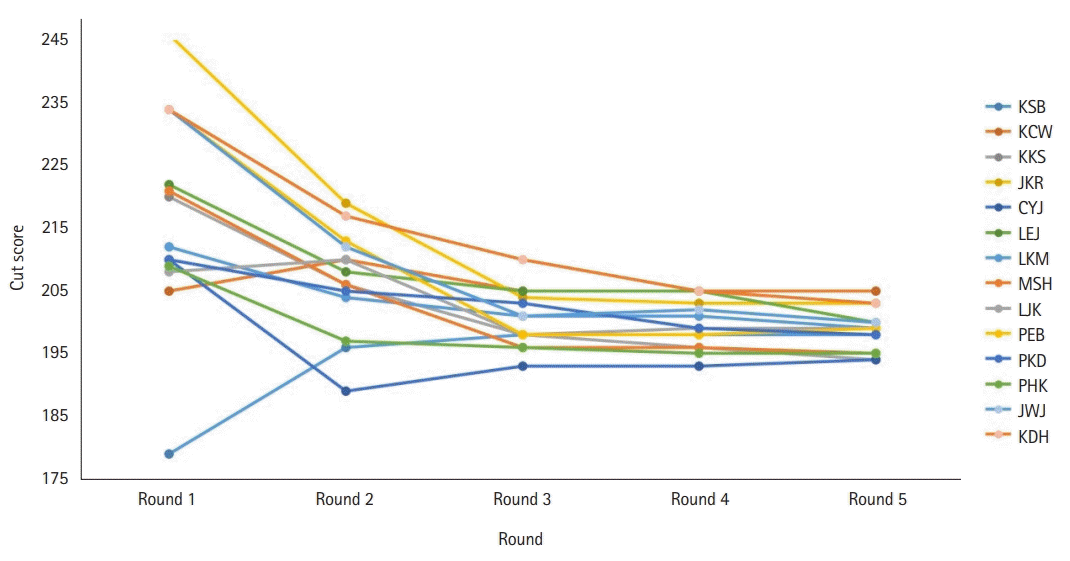Ethics statement
Since this study was a secondary analysis using de-identified data provided by the Korea Health Personnel Licensing Examination Institute, neither approval from the Institutional Review Board nor the obtainment of informed consent is required.
Setting
Unlike previous KMLEs, which were conducted in paper-based format, the 86th KMLE 2022, which was held from January 6 to 7, 2022, was the first exam that introduced computer-based testing in the written examination part [
8]. A total of 320 items were presented. A total of 3,305 examinees took the computer-based testing for a written exam, and the overall passing rate was 96.6%. On January 14th and 15th, 2022, a panel meeting was held to derive a cut score for the 86th KMLE written test result data.
Study outcomes
The primary outcome of this study is the cut score when using the yes/no Angoff method and Hofstee method. As the secondary outcome, the passing rates were calculated based on the cut score obtained from both methods.
Data sources/measurement
Before the panel meeting, the panelists must review all 320 KMLE items. They rated the importance and frequency of each item using a 3-point scale. In addition, through discussions on the characteristics of a minimum-competency physician, the panelists’ opinion on the minimum level of knowledge, skill, and ability required to perform the tasks of a physician was shared before starting the first round of voting for the standard setting process.
Details of the standard setting process using the yes/no Angoff are presented in
Table 1. The work was done over 5 rounds. The first round generally corresponds to determining whether the borderline examinee can answer each item based on the content and difficulty. While looking at each item from the examinee’s perspective, each panelist estimated and submitted the possibility of correct answers of the minimum ability group as 0 or 1. Of the 5 rounds, the most time is devoted to the first round. In this study, 450 minutes were devoted, including the discussion time.
In the second round, the previous round’s results were shown before voting. The probability of correct answers for each item and cut scores were obtained by adding all estimated correct answers presented by each panelist. Based on these results, the panel can see how their opinions differ. The average value of the cut score estimated by each panelist was obtained, and the total cut score and estimated passing rates were shown. Finally, at the end of the fifth round, there was no more meaningful change in the cut score and acceptance rate, so the process was terminated.
The Hofstee method requires the panelists to submit 4 values: minimum and maximum values of acceptable passing scores (C_min and C_max) and minimum and maximum values of acceptable failure rates (F_min and F_max). A cumulative frequency distribution graph is drawn based on the actual scores of examinees, and the point where the straight line connecting (C_min, F_max) and (C_max, F_min) meet this graph is selected as the passing score. In this study, the Hofstee method was conducted twice: before starting the standard setting process and after the second round of the yes/no Angoff.
Bias
The concept of the borderline examinee (i.e., minimal competence) may differ among the panelists due to their understanding of primary medical care. To supplement this, panelists who have experience as KMLE item developers provided a briefing on the background of the items to help other panelists fully understand the contents and goal of items.
Study size
Since this study was not intended to test the effectiveness of a specific intervention, the sample size was not calculated, and the performance data of all examinees for the written test of the KMLE were analyzed.






 PDF
PDF Citation
Citation Print
Print




 XML Download
XML Download